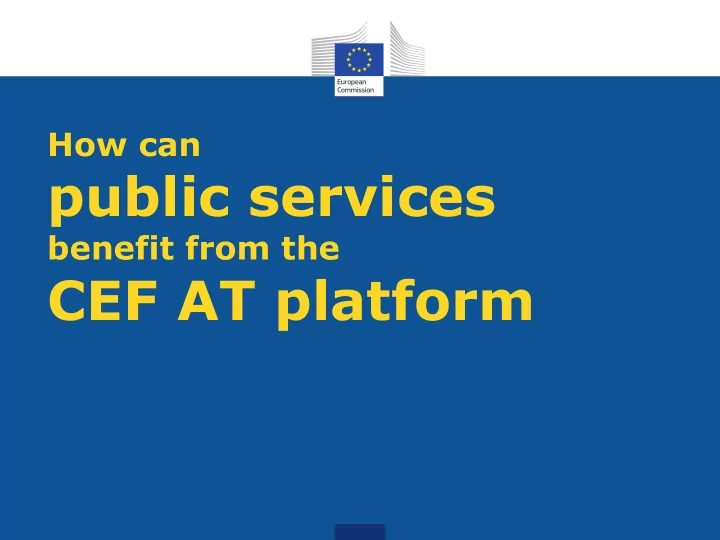

How can public services benefit from the CEF AT platform
Public services and machine translation • Enabling multilingualism • The role of machine translation • Now: MT@EC • Next: CEF AT platform 2
Interactions between actors in the Member States and the EU Member State X Member State Y Business A2B Citizens A2C Administration Administration A2A A2B A2C A2A A2A EU Administrations First type 3 Second type
Vision Wouldn’t it be great if I could start using a public service in any Member State from any place and obtain the information in my mother tongue? 4
The role of Machine Translation MT is the only viable solution for: quick and cheap access to information in foreign languages. understanding information received in a foreign language that otherwise could not be used or would require substantial time and costs to translate. making multilingual use of websites possible facilitating cross-lingual information search and analytics. That is why machine translation (MT) is a critically important technology for multilingual Europe
Machine Translation users Do not understand Understand both the source language source and target language What does Decide on Professional Other expert this text relevance translators users say? and next steps Improve text for further use Use as input for translation Decide Publish
MT@EC: already there for you! • • Released : 26 June 2013 • Languages: MT@EC translates between all 24 official EU languages • Technology: Statistical machine translation using open source software Moses co-funded by EU Framework Programmes for research and innovation • Development by DGT between 2010-2013 co-funded by the ISA programme (action 2.8) • http://ec.europa.eu/isa/actions/02-interoperability-architecture/2-8action_en.htm 7
MT@EC description • Delivery: - web user interface (human to machine) - web services (machine to machine) • Special features: • User interface in 24 languages • Source document format/formatting maintained [not for pdf] • Specific output formats for translation: tmx and xliff • Translation can also be returned by email • Can translate multiple documents to multiple languages • Indication of quality for language pairs (using BLEU Scores) • Feedback mechanism (using EU Survey) 8
MT@EC security • Secure hosting in the EC data centre • Access through ECAS (EC Authentication Service) • Secure document transfers : - over sTESTA *, a very secure private network between public administrations in the EU, separate from the internet - over the internet (through a secure https connection) • * You can check if your organisation has access to sTESTA on: https://portal.testa.eu/jetspeed/portal/homepage/about.psml. 9
Who can use MT@EC today ? European institutions and bodies: Commission Economic and Social Committee Parliament Committee of the Regions Council European Central Bank Court of Justice European Investment Bank, Court of Auditors etc. Online services funded or supported by the EU Public administrations in the EU/EEA countries 12
MT@EC... built on EU data Euramis 725 million sentences [end 2014] Growing at 2.6 million per month All 24 languages [different volumes] "EU documents" [EU subjects and language] 13
Free access to MT@EC for public administrations staff • Get an individual ECAS user name and password (self- registration) using your work email address. [go to https://webgate.ec.europa.eu/cas/eim/external/register.cgi and follow the instructions] • Send an email to DGT-MT@ec.europa.eu asking for the activation of access to the service. • DGT will activate your access and inform you by email. 14
Online services connected to MT@EC (status: July 2015) Service Description/URL/use IMI Internal Market Information System – an intranet for more than 7000 public administrations in the EU Member States http://ec.europa.eu/internal_market/imi-net/index_en.html free-text message exchange SOLVIT An on-line problem solving network concerning misapplication of Internal Market law by public authorities. http://ec.europa.eu/solvit/ free-text message exchange nLex A common gateway to National Law http://eur-lex.europa.eu/n-lex/ translate results of queries CircaBC Communication and Information Resource Centre for Administrations, Businesses and Citizens (collaborative spaces) https://circabc.europa.eu/ 15 Translate documents
What next? from MT@EC... to the CEF Automated Translation platform CEF AT will: build on the existing MT@EC service - but not be limited to it • put emphasis on secure , quality , customisable MT • for pan-European online services - but not be limited to them be a multilingualism enabler – not only MT • 16
Customisation for online services connecting to the CEF AT platform (starting from MT@EC) Service Description/URL/use Europeana The digital European Library, common, multilingual access point to digital resources of European heritage. ODP The pan-European O pen D ata P ortal for accessing open data infrastructures distributed over a EU and MS data repositories. EESSI The E lectronic E xchange of S ocial S ecurity I nformation, a platform between 32 countries (EU+EFTA). ODR The O nline D ispute R esolution platform for resolution of online contractual disputes between consumers and traders, linking all national Alternative Dispute Resolution (ADR) entities. e-justice A portal which is a single point of access to law, enabling EU judicial cooperation. SaferInternet Services to make Internet a trusted environment for children. 17
What would CEF AT bring to users? • Faster and more secure translation • More pan-European public online services offering machine translation and other multilingualism possibilities, adapted to the needs of their users and • Better quality translation in general • Translation for specific domains (starting with the domains relevant for the DSIs) More and better data are needed for all languages and for more domains.
Currently: MT@EC translates "typical EU texts" MT@EC built on "EU translations" (Euramis) Euramis covers all 24 languages but with different volumes. (ranging from 97 million segments in EN, 58 M in FR to 2.8 M in Croatian and Irish (the rest between 22 and 38 M) Euramis (and MT@EC) covers EU policies, subjects and language but not "everyday language" MT@EC covers many domains but there is currently no possibility to focus on any one of them. More "in domain" data are also needed.
Questions on MT@EC? dgt-mt@ec.europa.eu DGT Conference on MT in translation practice Brussels, 4 December 2015
Recommend
More recommend